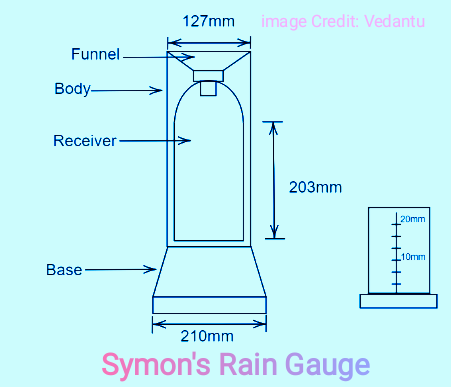Table of Contents
What is Symons Rain Gauge
Symons rain gauge is non-recording type rain gauge. It is only collect rain water. It does not measure the reading of collected water. After rain water collection, it is measure by graduated cylinder.
The amount of rain collected in the graduated cylinder directly reflects precipitation in cm of water depth. The amount of water collected in cm divided by the area of the hole transmitting the light of the meter in cm2 equals the depth of precipitation in cm.
The receiver, also known as the junction bottle, measures 175 mm rainfall. In areas with high precipitation, rain gauges with collectors of 375mm or 1000mm capacity are used to measure precipitation.
Detecting the start and end of rain and measuring the intensity of precipitation requires a continuous record of precipitation over time. For this you should use a recording rain gauge.
The concrete block that forms the base of the Simon rain gauge is 600mm x 600mm x 600mm.
The Simon Rain Gauge collects rainwater in a cylindrical bottle and manually measures it daily.
Simmons rain gauge is a type of non-recording rain gauge used in India. It consists of a cylindrical glass bottle and a funnel should be inserted so that water fills this container during this rainy season. Once the water filling is complete, it can pick up 1/2 inch of rain. This precipitation was measured at 8:
30 AM.
Rain falling on the funnel is collected in a receiver and
is measured on a special measuring glass graduated in mm of precipitation. Rainfall is measured daily at 8:30 AM. It should measured 3-4 times daily.
Symon’s Rain Gauge Diagram
It consists of a circular receiving area with a diameter of 127mm connected to a funnel. The
collector’s edge is set at a height of 30.5 cm from the floor.
The funnel receives rain and directs it to the funnel. The
funnel and collection container are housed in a metal container.
The catch bottle normally holds up to 10 cm of rain.
In case of heavy rain, measurements should be taken frequently. The last reading should be taken at 8: 30 AM and the sum of the previous readings over the last 24 hours should be entered as the total precipitation for the day.

How Does Symon’s Rain Gauge Work?
The concept of unit precipitation is meant to be independent of area size. If you just want to measure precipitation, the area considered can be large or small.
If we take the smallest possible area and absorb the water that falls as rain until it is lost or drained, then we must accurately calculate the depth of water in that small area and measure it in the appropriate units to be included.
You can get the amount of precipitation (in centimeters). A small area should be chosen to have similar weather characteristics to the large area it reflects.
Note: There are two reasons for keeping the funnel lip 30 cm above the natural surface.
- Reduces the amount of water splashing into the funnel to almost zero.
- Keeping the meter height above 30 cm reduces the amount of rainwater collected due to the wind eddies created by the meter.
Advantages of Symon Rain Gauge
- Useful for measuring any type of precipitation including snow and rain.
- By removing the funnel collector, a substantial amount of rainfall accumulates and also plays an important role in estimating cold climates.
- Collected rainwater is measured daily.
Symon Rain Gauge Disadvantages
- This type of rain gauge only collects rain.
- This meter does not record and measure precipitation at the same time.
- Simon’s rain gauge only displays the amount of rain that has fallen.
- One of the major drawbacks of the Simmons Rain Gauge is its inability to determine when it started raining, how much it rained, when it stopped, and variations in rain intensity during the rainy season.
What is the Least Count of Symon’s Rain Gauge?
Simmons rain gauge minimum scale is 0.2 mm. Precipitation can be estimated at about 0.1 mm.
